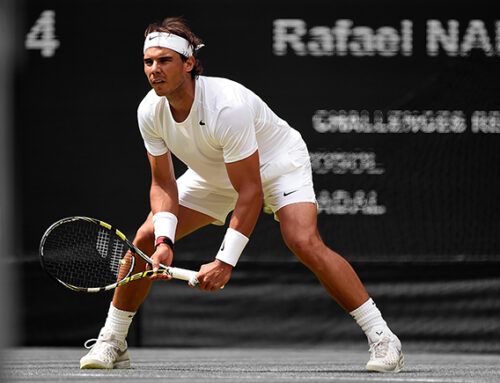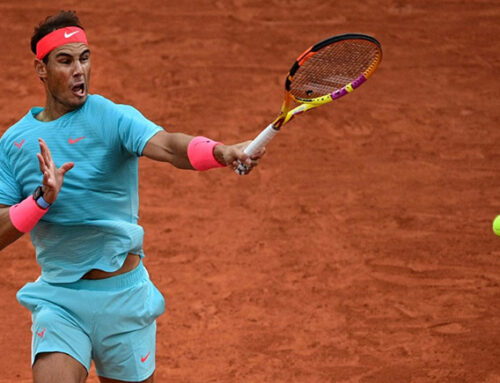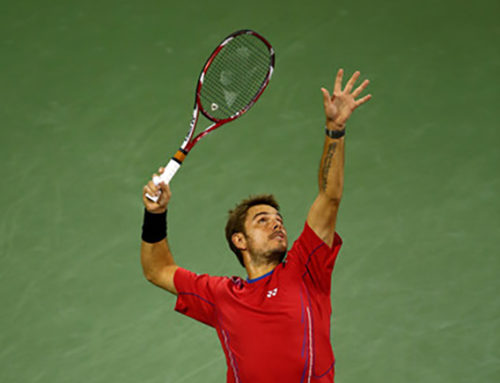Tour Patterns: Goffin vs Dimitrov
(2017 WTF)
Watching David Goffin and Gigor Dimitrov play twice in a handful of days made for some fascinating tennis. Typically weeks or even months go between two players facing each other twice. In the interim perhaps dozens of matches have been played, and the intricacies of a specific opponent are lost in a sea of points played and tennis balls struck. But the round robin format of the World Tour Finals creates an interesting situation – one unique in men’s professional tennis. A mere five days separated the repeat match-up between these two players.
This creates an opportunity to analyze just how players respond to patterns of play – the types of tactical adjustments they make from recent match experiences. We will look at two patterns of play – one from each of their matches at the World Tour Finals this year. The first pattern is one which Dimitrov put to good use throughout the tournament against all of his opponents, including in his 6-0, 6-2 win over Goffin on the Wednesday of the tournament. The second is Goffin’s adjustment made to counter this pattern in their meeting in the final of the tournament.
Dimitrov Using the Slice
A large piece of Grigor’s success on hard courts his year has been his intelligent use of the slice backhand. 2017 has seen Grigor move from checkers to chess in his level of tactical sophistication. This was touched on in detail in Tactical Tennis’s article: “Grigor Dimitrov – Here To Stay” (Warning, GIFs abound!). While it did not serve Dimitrov well on the clay, Grigor’s use of the slice was instrumental in his first Masters title win in Cincinnati. He continued to use it to good effect at the World Tour Finals:
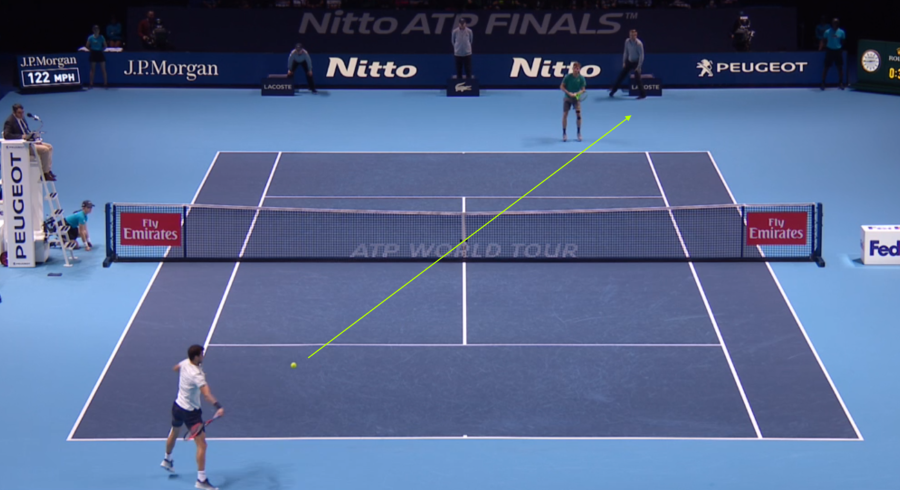
We start with the shot Dimitrov originally wanted – the inside out forehand. Most of the time, this is the shot Dimitrov wants to be hitting, and this is the place he wants to be hitting it from. Grigor’s forehand is one of the best on tour, and it is the shot he builds his play around. Typically once he gets this ball, Dimitrov will keep control of the point from start to finish. But things don’t always go according to play. Here Grigor plays a good quality inside-out forehand into Goffin’s backhand.
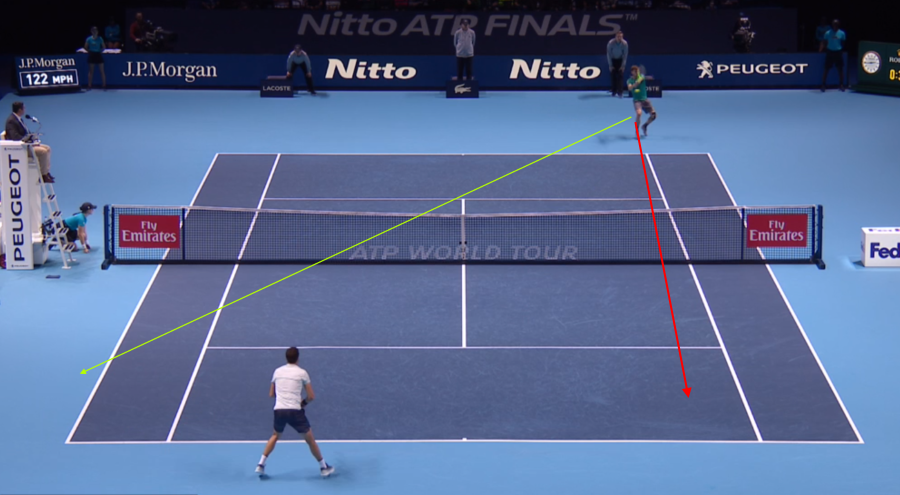
Now Goffin could play the backhand down the line (the red line), but doing so is pretty high risk. On the previous shot, Goffin had to respect the possibility Dimitrov might have played the ball inside-in, and so David is pushed back here. He’s a good 6 feet (nearly 2 meters) behind the baseline. Any ball played down the line from here would lack authority, giving Dimitrov the open cross-court to attack with his next forehand.
But Goffin’s backhand is good. Very good. So he does something many players cannot do. David gets the ball back cross-court, and immediately threatens Dimitrov’s control of the point. Remember Dimitrov is expecting to get another forehand on his next ball. Once he hits that first inside-out forehand, Grigor is used to keeping control, but Goffin turns the tables with the angle and pace of his shot.
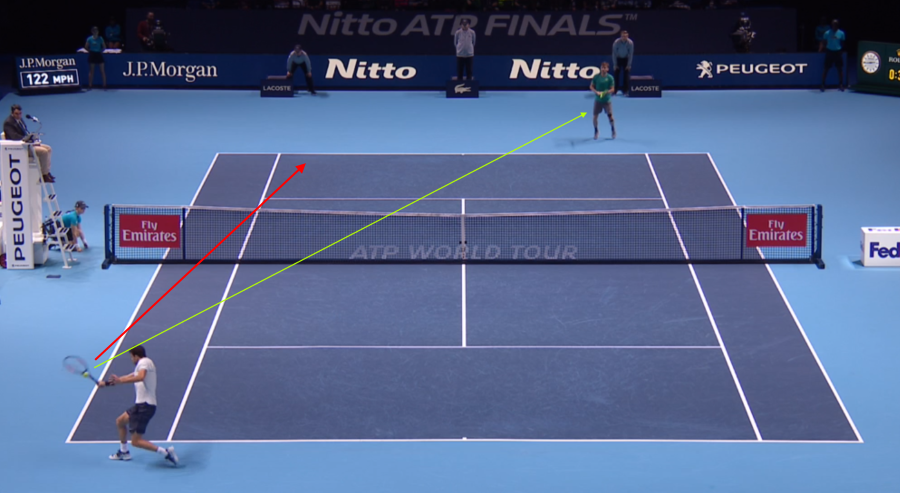
We can learn so much just from this one image. David has forced Grigor to hit the slice, and Grigor’s options are somewhat limited. Note David’s aggressive cross-court position in this frame. Goffin has zero fear of Grigor taking this ball down the line – he is anticipating the cross-court ball and placing all of his eggs in that basket. Why is that?
Because he’s reading the game. Grigor was expecting to hit a forehand, and when Goffin got as much angle and pace as he did, Dimitrov was caught off-guard. Grigor isn’t balanced – he’s scrambling a little to hit this ball. Anything Dimitrov hits on the red line will be a weak reply, with a higher chance of error. It would be tantamount to surrendering the point, and Goffin knows it. So Goffin camps the cross-court ball, knowing full well that’s where the ball is going.
Grigor knows he’s in danger of losing control of this point. There is only one good play for him to make here – and it is the play that he chooses. Dimitrov plays the deep cross-court slice. The depth is critical – if Grigor drops it short Goffin will step in, take the short forehand down the line and come in for a likely easy point. With depth though, Goffin is stuck in building mode – he must continue to construct the point.
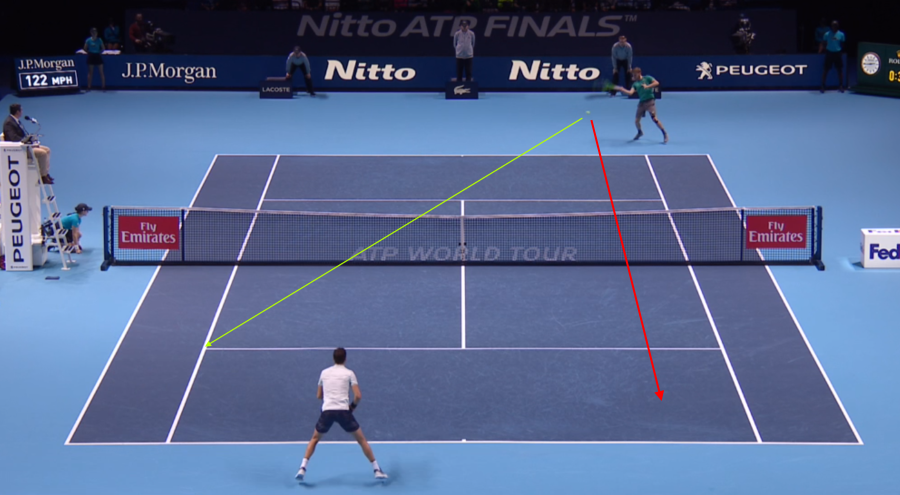
Goffin gets the forehand that he wanted, but not in the position he wanted it. As with the backhand, David is a good 6 feet behind the baseline. He’s in a positive position, but not a commanding one. Could Goffin play his forehand along the red line? Sure, but it’s not the play he wants yet. If he plays the red line, David is playing straight into Dimitrov’s strength. Not just the forehand, but the running forehand – the shot Grigor hits maybe better than anyone else on tour right now.
To add to this, Dimitrov’s recovery position is just about perfect. Dimitrov is ready for the Goffin forehand down the line. Grigor is leaving the backhand open, and so Goffin does the predictable thing. He takes his forehand inside-out, looking to build on his advantage.
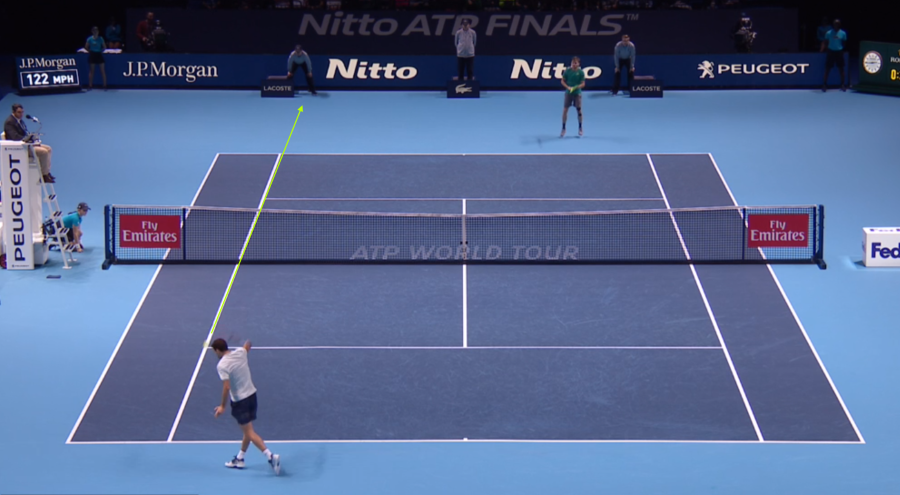
The problem is that Goffin plays directly into Grigor’s hands. Dimitrov isn’t just expecting the ball to come back into his backhand, he’s waiting for it. Balanced and ready, Grigor drives the backhand topspin, down the line for a clean winner. Goffin has no idea what’s coming – he’s anticipating another ball in his backhand corner.
Dimitrov has three variations on this pattern. The first is this – stepping in to take a topspin backhand down the line. The second is to take a short slice down the line. The third and final is to run around the ball and hit a forehand. In all three variations Dimitrov has gained control of the point off a cross-court slice backhand. It is predicated on the fact that taking the low slice down the line is a high-risk play for the Goffin backhand. Grigor is reading the positioning and his opponent to anticipate what’s about to happen. With that anticipation comes a huge advantage.
Dimitrov would ride this pattern (and others) to a dominating 6-0, 6-2 win. When they met again 5 days later, Goffin could not let this go unanswered.
The Turnaround
Goffin is one of the more tactically astute players on the tour. He has a very balanced game, which gives him tools with which to respond to a variety of situations. It’s important to note that Goffin didn’t necessarily need a bullet-proof response to Dimitrov’s pattern. David simply needed a response that could create doubt in Dimitrov – something that inhibited Dimitrov’s ability to anticipate with full confidence what was coming next. Not only does Goffin have a response, he executed it on the very first point of the match.
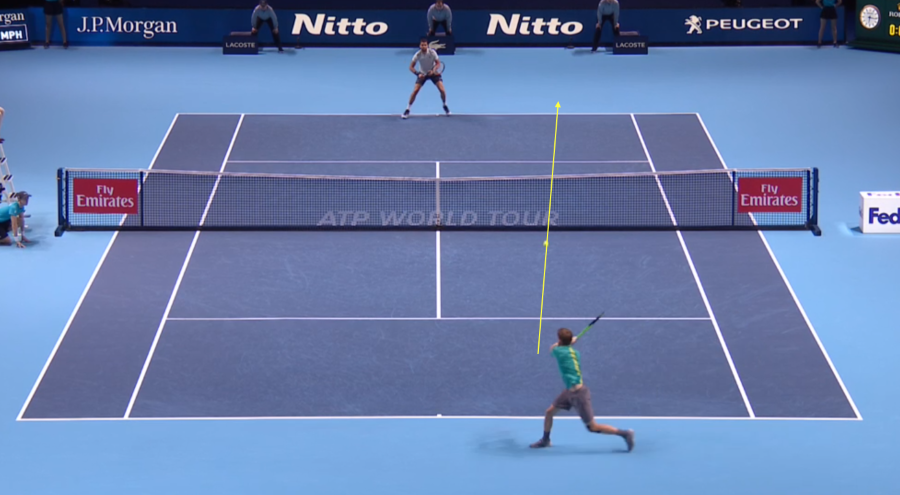
The point starts with a Goffin return to Dimitrov’s backhand. This is exactly the return that Goffin wants – if Dimitrov gets to hit a forehand as the first ball of a rally his odds of winning the point are significantly better.
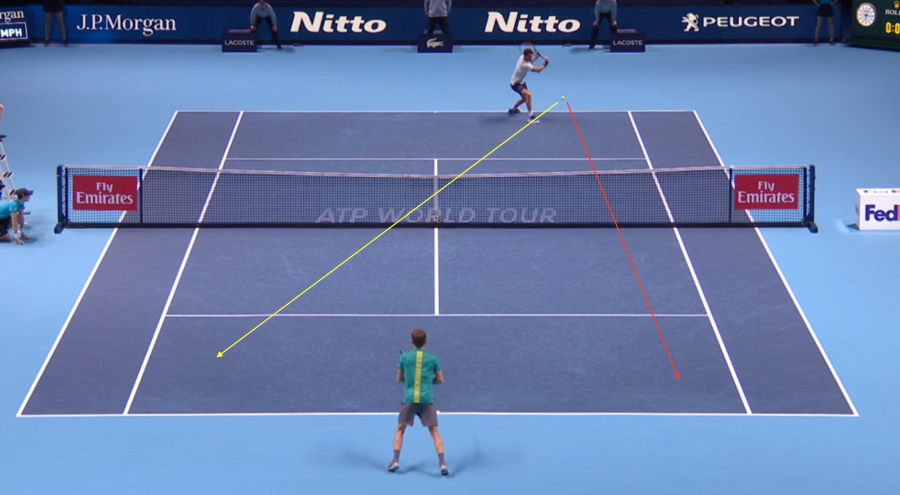
It’s telling how fond Dimitrov is of the pattern that he immediately goes to the slice backhand here rather than hitting an aggressive topspin backhand. Dimitrov theoretically has two options with the slice here, but the yellow line is his best choice. If we look at Goffin’s position, he is well placed to cover a ball down the line from Dimitrov. Additionally Goffin handles the low slice ball off his forehand side better. Playing the red line will put Dimitrov in poor position – Goffin can play an aggressive forehand either cross-court or down the line, and Grigor will struggle to anticipate the next ball.
If it had been months since they last played, Goffin might have had to respect the down the line ball more in this situation. Instead it had been a few days, and Goffin was not at all surprised by the play. He was reading, anticipating and quickly able to change the dynamic.
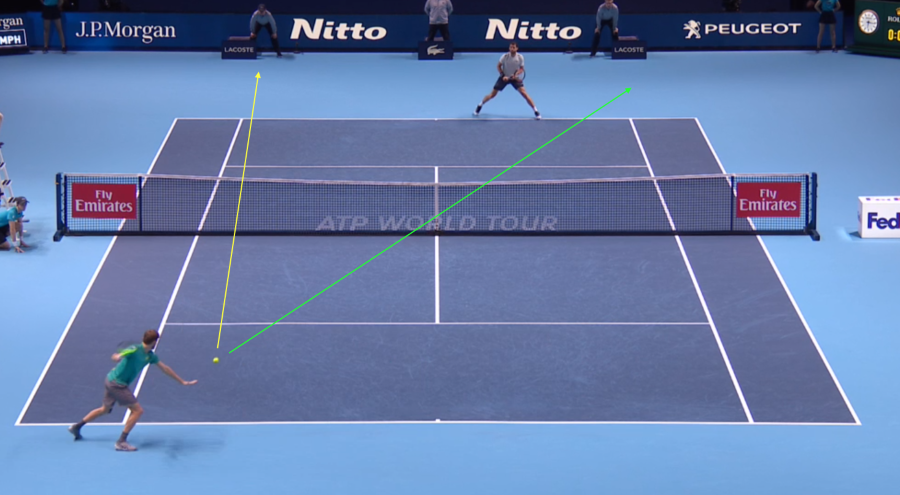
David moves aggressively on the cross-court slice, setting up to hit the forehand. In their first meeting in the tournament David ran around this ball several times. However when he did so his anticipation was lacking – it was reactionary. Goffin was hitting the shot from deeper behind the baseline, and he simply wasn’t as well balanced to be able to hit the ball with any level of real aggression.
This time is different. David is closer to the baseline, and his weight is biased forward. Goffin is significantly better prepared to hit the forehand, and that opens up options for him. Goffin can take the ball aggressively in either direction, but Grigor expects this forehand to come back into his backhand corner. Dimitrov has several reasons to expect it – his forehand is known as the stronger wing, and players have a history of attacking his backhand side.
When Goffin then takes this ball inside-in, Dimitrov is left completely flat-footed. Much of Dimitrov’s ability to build offense off the slice backhand is predicated on his ability to anticipate the next shot. Lacking that anticipation, Dimitrov loses a critical fraction of a second. Goffin was not flawless in his execution of the strategy – but he did not need to be. Simply executing it successfully a handful of times, especially so early in the match changes the dynamic between the two players.
Suddenly, from the very first point of the match, Dimitrov has been given reason to think. Where just a few days earlier he was almost on auto-pilot against Goffin, playing his favorite patterns without hesitation (or resistance from his opponent), suddenly one of those patterns seems higher risk. It isn’t that Dimitrov can’t use this play any longer – it is still a good pattern of play for him. It is that the next time he does it, Dimitrov feels pressure to make it a little better – the slice a little deeper, perhaps a little faster. Goffin has given Dimitrov real reason to push towards the edges a little more, which is where errors lie.
Conclusion
Ultimately this was not the only adjustment Goffin made, and although David was able to make the match extremely competitive he was unable to overcome Dimitrov. Goffin was within a small handful of points from winning however, a marked improvement over the crushing defeat he had suffered mere days earlier. Truth be told, if David Goffin had served better he likely would have walked away with the title.
Each match is filled with opportunities such as these. Opportunities to either impose your own desired patterns upon your opponent or, recognizing their desired patterns, to counter them. This is ultimately what competitive tennis is all about – the struggle over who can execute their strengths to best effect. Happy playing!

